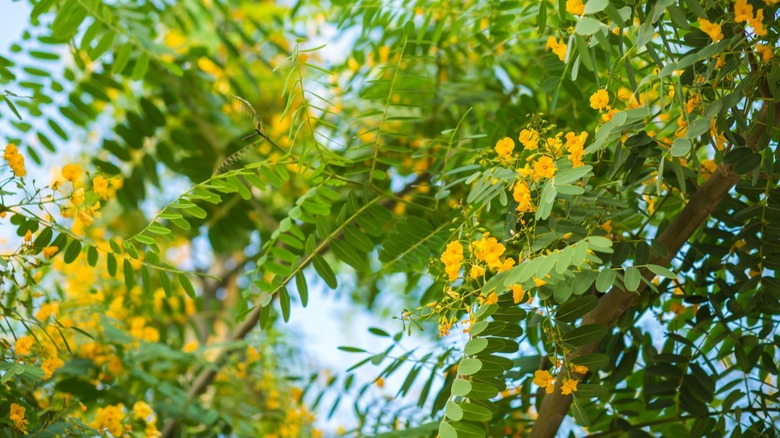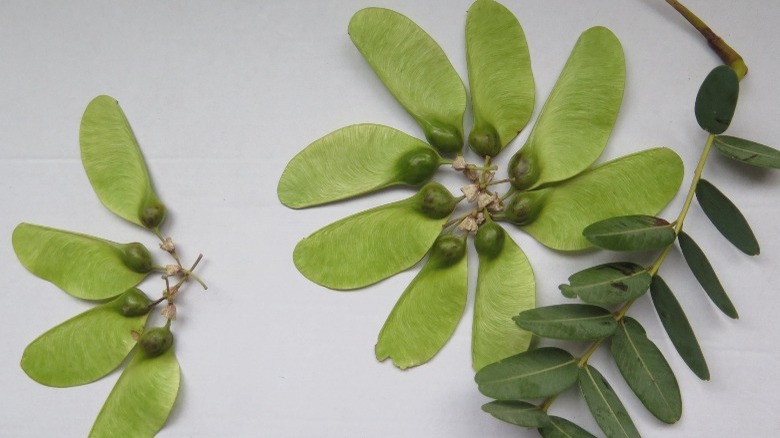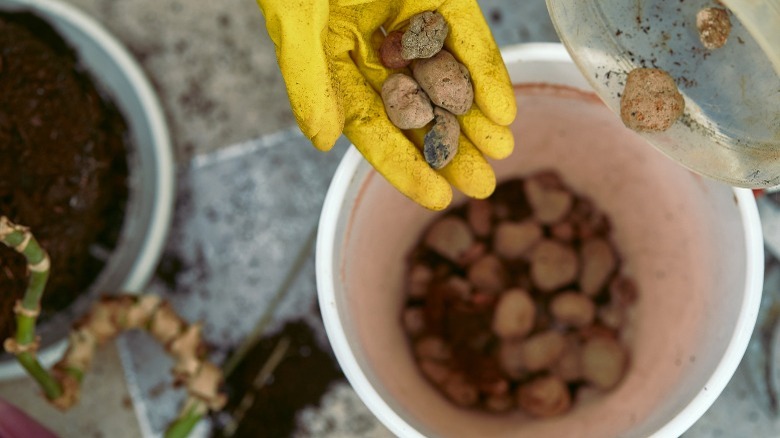How To Care For A Tipu Tree
The tipu tree, scientifically named Tipuana tipu and known as the Pride of Bolivia, is a fast-growing, tropical tree native to South America. According to Urban Tropicals, gardeners who live in climate zones that the tipu tree can tolerate love to have it in their gardens because of its shade-providing properties and the beautiful flowers that attract butterflies and other wildlife to the backyard.
In addition to the flowers, Trees of Stanford describes the foliage of the tipu tree as attractive with dark green, pinnate, oval-shaped leaves that are arranged in a staggered pattern of 19-23 leaflets. The underside of the leaf is a slightly lighter shade of green, while the tipu tree's flowers are bright yellow or orange — frequently referred to as apricot-colored. These bright blooms create a carpet of petals as they go to seed, which can be an annoying issue to deal with if this tree is planted somewhere inappropriate. In addition, the fruit of the tipu tree are its seeds, and much like maple or sycamore trees, the seed pods have wings that cause them to spin as they fall, slowing the fall and spreading them far and wide. Again, this mess and its ability to grow and spread quickly can cause complaints among critics of the tipu tree.
How to use a tipu tree in garden
Tipu trees grow quickly, with a wide canopy and pretty flowers. Those two factors are why Moon Valley Nurseries recommended the tipu tree as an excellent choice for adding shade and year-round beauty to your garden. They thrive in hot environments and can grow up to 98 feet in height but also provide ample shade with their thick foliage and swooping boughs.
Being fast-growing above ground often means that trees are fast-growing beneath the soil as well, and the tipu tree is no different. Gardening Know How warns about the importance of site selection for these trees. Their trunks flare out at the base, and the roots they send out tend to be quite shallow, which can combine to crack pavements or sidewalks nearby. As a result, this tree should be kept away from buildings, roads, fences, or other structures to avoid property damage.
How to grow a tipu tree
The first and most important factor in growing a tipu tree is climate. These trees will simply not tolerate cold. The Urban Forest Ecosystems Institute noted that tipu trees only flourish in mild climates, in hardiness zones 9 through 11. If you live outside these areas, it is possible to grow saplings in greenhouses or containers to protect them from the cold. Still, if you want to plant into the soil and allow the tree to become truly established and provide shade to your garden, it must be planted in regions where freezing temperatures are rare.
Having said all that, if the climate is warm enough, tipu trees can thrive wonderfully. They are so adaptable to different soil types that they are even cited as a problem plant by Invasives South Africa. Notably, it is not uncommon to see tipu trees out-competing native plant species along river banks and waterways. This is partly because the saplings require plenty of moisture to establish themselves. However, they become much more drought-tolerant after the first few years and only occasionally require watering, notes Desert Horizon Nursery. If you want to grow a tipu tree from seed, you should propagate it in shallow soil and keep it well-watered in a warm, well-lit environment. Useful Tropical Plants advised putting seedlings into individual containers when 2 to 3 inches tall and then planting the saplings out in soil (or a roomy pot) when they are around 1 foot in size.
How to care for a tipu tree
As African Legacy explains, tipu trees are considered an invasive species in South Africa due to their large canopies, which tend to shade out native species. They are also listed as intrusive because of the way their helicopter seeds can spread a great distance and ultimately because they grow very quickly. However, if you have the right climate and can keep the roots well-watered in the first year, that's about all it takes to grow a tipu tree of substantial size. Urban Perennials recommends giving your tipu tree full sunshine or very partial shade, depending on where you grow it. Young trees aren't drought-resistant, though, so resting on how hot the sunshine is, they can require watering two to three times a week in the first year or two.
As previously mentioned, if you have a Tipuana tree that's growing close to a house, pavement, or other structure, then there could be an issue with the roots coming in and disrupting or cracking the concrete. As a precaution, AP Nursery suggested digging a 3-foot-deep trench filled with gravel or shingles and lined with plastic to prevent wandering roots. They also point out that the tree will benefit from fertilizing if your soil contains a lot of clay or sand. Compost or an all-purpose fertilizer should be enough to give the tipu tree its needed boost.
Is the tipu tree toxic?
According to a risk assessment carried out by Hawaiian Ecosystems at Risk (HEAR), tipu trees are not toxic to humans, pets, or any other animals. In fact, many ruminants will naturally browse lower branches for young leaves, and this needn't be cause for alarm. Of course, any animal that eats a large amount of raw plant matter when it's not a typical part of their diet may end up in distress. So, while chemically, the tipu tree may not be toxic, be aware that if an animal eats too much, it may still cause an issue.
Almost all growers of the tipu tree love it for shade and foliage. However, the leaves, sap, and unripe fruit also have some beneficial uses. Per Useful Tropical Plants, the leaves, flowers, and seeds can potentially be used to create soaps, and people can also utilize the sap's dark red color to make clothing dyes.
How to repot a tipu tree
Tipu trees can and do grow well in containers; however, Plant Ark pointed out that when doing so, they are less likely to produce the striking apricot-colored foliage that many adore. If you are growing a tipu tree in a pot, it will eventually grow so much that you will need to repot it. This should be done in winter when the plant is most dormant and most likely to survive the shock of repotting. First, soak the soil and roots, so the tree is easy to remove from the container. Next, lay the tree on its side, loosen the pot with a knife and remove and shake off excess soil to inspect the roots.
Backyard Gardener advises pruning the roots after the tipu tree has flowered when grown in a pot. Remove any roots that are too tangled, moldy, or dying, and trim them back into a roughly symmetrical shape, then soak well in water. The new pot should be twice as wide as the rootball and filled at the bottom with pebbles. It should also have enough well-draining soil to raise the rootball level with the top of the container. Make sure the tipu tree is centered in the pot and backfill with soil. Water very well initially to ensure the soil is well-distributed around the roots, and keep well-watered for several months after transplanting to help with the shock.





